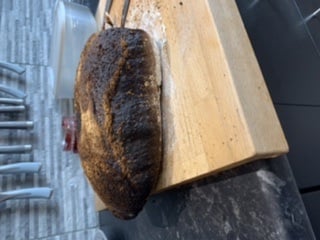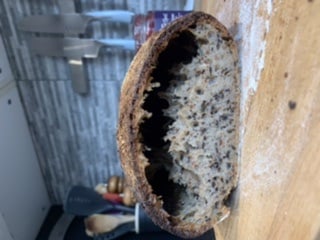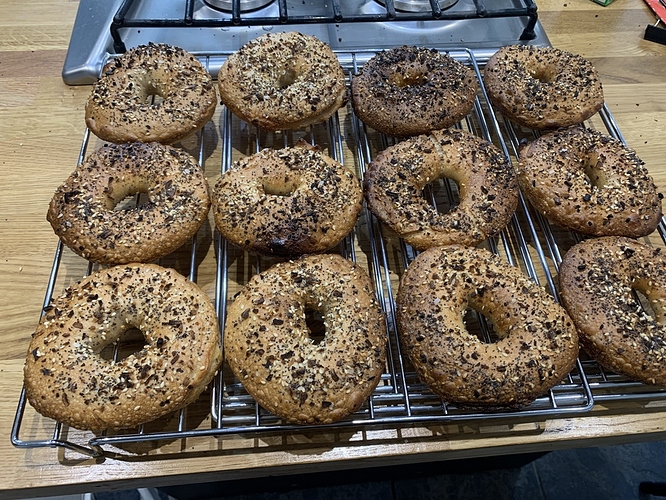You should try living in Scotland…we’re just cold here all the time! Did you get the latest model with the slow cooker ability it’s about £180
Forgot to say, I have a proving function on my oven that I never use…should I use it rather than buying a separate prover? I usually just leave the dough on the worktop but does take nearly all day to prove
Yes the Brot and Taylor I got has a slow cooker, yoghurt functions in addition to proofing. You should consider trying your oven’s proofing function, just try it with some water and then take the temperature of the water to see how accurate it is. You would certainly save money that way. My oven doesn’t have that function and I was finding it frustrating using the oven with the light on and the door propped open to proof because I would want to use the oven for other things.
Interesting idea! Just my random two cents worth, but that seems like a lot of sesame seed oil. That oil can be magic, but the flavor is so strong. I’ll be looking for your results before I try it.
What are you thinking Kevin, maybe just 1% for toasted sesame oil?
My assumption was that you were using the sesame seed oil in addition to the sesame seeds in your recipe. Sort of as a flavor enhancer for that. On that assumption, I would probably start with a pretty small amount… maybe 1/2 teaspoon.
If you are using 500g of flour, I would guesstimate that at less than 0.5%.
However, I do notice that I seem to find certain flavors as exceptionally strong that other people do not. Sesame seed oil, truffle oil, etc. I love the flavors, but I find that they can overwhelm if used in what I consider large amounts (which others might consider small amounts). So take my comments with several grains of salt.
Kevin your assumption is correct, I was thinking of enhancing the sesame flavour by using some sesame oil in addition to the same black and white toasted sesame seeds. I guess I’d need to experiment with how much and start lower 0.5% or so and work up. I had asked someone who posted on IG how much they used in their sesame sourdough and they used around 3%.
I tried the loaf using my oven dough proving setting…disaster…I way over proved the dough and it collapsed! Still baked it…but was much heavier and more dense. I made it again yesterday and went back to my old method. Worked perfectly! I LOVE that loaf. Thank you so much Benny for pointing me in the direction of the “Perfect Loaf” website. I love his recipes. I made bagels yesterday that at last worked. I’d made them twice before using breadtopia’s recipe and they were a disaster. Managed at last to get Canadian bread flour…made all the difference. Please please…keep posting your recipes. I love trying them. I’d love to try your baguettes…can I get the recipe please🙏
Hi Jane, I’ve enjoyed Maurizio’s recipes from The Perfect Loaf, the several that I have tried. I’ll add the recipe that I followed for the baguettes to that posting, the most recent ones have been my favourite for flavour.
You should be posting some of your bakes, it sounds like they have been excellent so share them with everyone here. I’d love to see your bagels, I haven’t tried them yet. Before baking sourdough I never gave our Canadian flour any thought, then I started to read posts about the high protein Canadian flour and realized many people covet our flour, cool.
I’m just getting so excited by my sourdough starters at the moment and the things I can produce using them. These were my bagels…by no means perfect yet, but can’t wait to try them again
Wow those are beautiful Jane, you should post these in their own thread in the Baker’s Gallery, they are worth showing off.
Benny, I made this loaf yesterday and it was a complete disaster. Don’t know why as Ive made it a few times. It totally stuck to the bannetone (as previously discussed in another thread) and then puffed up the crust hugely and left the rest of the loaf behind. Ive attached photos of the “ugly” loaf, however It still tastes lovely but is rubbish sized slices. Yesterday I tried a no knead sourdough from this website (its currently in the oven)and was sitting down looking at recipes and seeing if I could up the hydration on this loaf and essentially make it like a no-knead loaf. In the recipe above you say that this loaf is 78% hydration, but when I look at the figures I get it coming out at 71% hydration. Please could you explain to me how you get the 78% hydration as I must be doing something wrong with my maths


@janegove, I’m guessing you didn’t add the water that is in the levain, this happens to me all the time. Since the levain is 100% hydration and we’re using 92 g, 46 g of it is water. Added to the 344 g of water used during autolyse gives you 390 g of water in 500 g of total flour which gives you a hydration of 78%.
Benny, I did add the water in the Levain but I also took the flour in the levain into account. Should I not? So I got 546g flour and 390g water which I get 71%
Benny, I’ve just realised my mistake…I’ve been assuming the flour in the levain is “additional” but if I’d actually done the maths and not just take the 500g flour as total for the loaf and the levain is in addition to the 500!
Benny, thing I’m struggling to work out is when a loaf has completely finished bulk fermentation. I either under prove or over prove. I always use a cold retard overnight in fridge and bake next day but it’s a gamble as to when it is right to put it in the fridge. My loaves recently have been very moist inside almost to the extent of “wet”. Tonight’s loaf I gave an additional 25 minutes cooking after it had already had an hour. The recipe only said 35mins. (Eric’s no knead sourdough in breadtopia). I did use a temp probe tonight and the inside was 208 degrees F but when I pulled the probe out there was sticky dough left on it (like when u test a cake at end of baking). I’ve left it to completely cool and not been tempted to slice into it today so I’ll check tomorrow. Have u got any advice for me? Sorry to put this on a public forum but I don’t know any other way of contacting you. Thanks for all your help. J
@janegove I probably didn’t make it clear enough in my post, so I am sorry if it was written in a way that wasn’t more clear Jane.
I’ve had that plenty of times @janegove so I can completely relate. Can I share a recent trick that I have been using to fine tune my sourdough baking? I am now using an aliquot jar to gauge bulk fermentation. An aliquot is a small portion, in this case a small piece of dough, about 30 g, is removed from the dough after the first set of stretch and folds and placed into a small narrow jar with straight sides. Make sure you press the dough firmly into the bottom of the jar trying to eliminate any air pockets. I got this idea originally from an IG post of Kristen’s (Full Proof Baking). This dough will ferment at the same rate as the larger dough mass assuming you keep it in the same conditions as the larger dough. You will mark the starting point and can very accurately measure the volume rise of the large dough by the dough in the aliquot jar.
I’ve always had a very hard time measuring rise because I bulk ferment in a Pyrex 8” x 8” square dish and make one loaf at a time. So when the dough starts out it isn’t even touching the sides of the dish. I’ve started using the aliquot jar in the past 3-4 bakes and now I can really measure the rise so if the end result of the crumb is a bit too tight I can next time let bulk go further with confidence by using the aliquot jar and get a more fully fermented loaf. Or vice versa of course if over fermented I can dial back on the fermentation next time.
Now one thing to take into consideration is that each time you manipulate the dough through coil folds or stretch and folds, you are degassing the dough somewhat, even when you do it gently. So when your aliquot jar shows 50% rise, the main dough will not have risen 50% because of the degassing during stretches. So it a recipe says pre-shape or shape the dough when it has risen 50% if you go by 50% in the aliquot jar, you will be a bit under. I’d say 60% or greater rise at the minimum in the aliquot jar is probably around 50% in the main dough. The best use of the aliquot jar is when you have made a bread one time and you want to adjust the fermentation the next time. So if you wanted it to be more fermented because it was a bit underproofed and that time the aliquot jar showed a 50% rise, then next time you might wait to end bulk when the aliquot jar showed 60 or 70% rise. It is super helpful to adjust your bulk fermentation.
